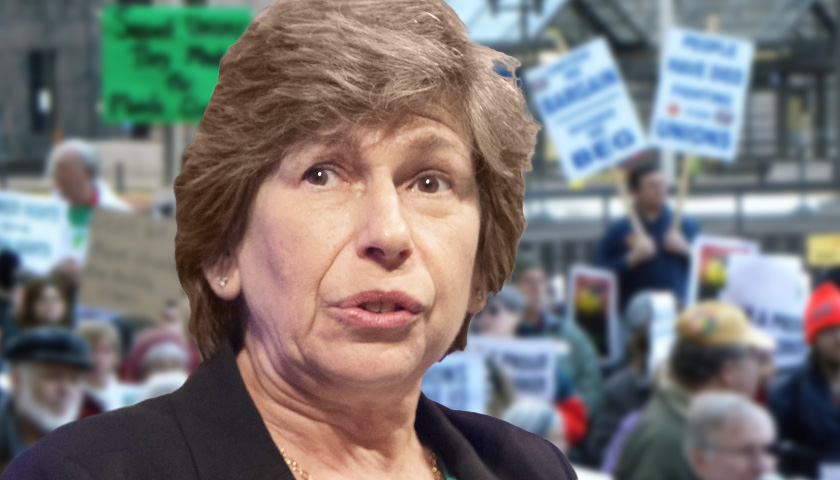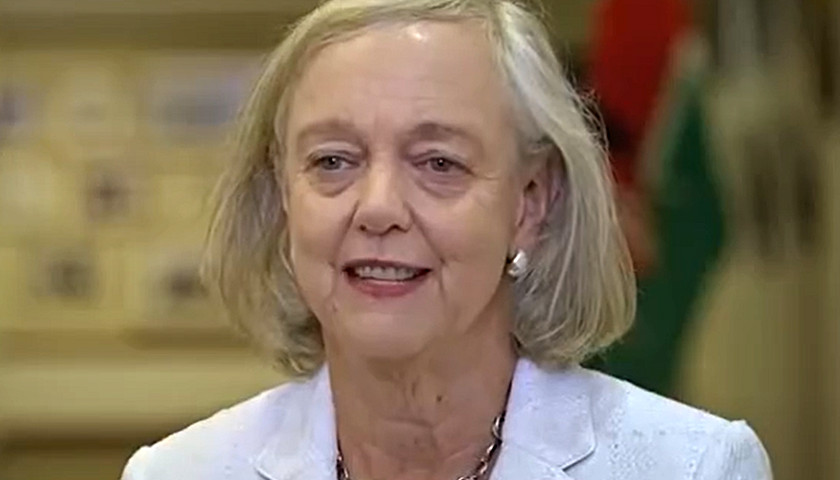by Ben Weingarten
Randi Weingarten, the powerful president of the American Federation of Teachers, hasn’t been a working teacher in more than a quarter of a century.
Of the six years she spent teaching social studies, half of them appear to have been as a substitute. Yet despite the long absence from her short tenure in the classroom, the union leader described herself during a recent congressional hearing as being on leave from Brooklyn’s Clara Barton High School.
Through her decades of union activism, Weingarten has clocked service time as a public school teacher, enabling her to accrue an educators’ pension on top of the more than $500,000 in annual salary and benefits she earns as a labor executive, according to records obtained by the Freedom Foundation. She would receive about $230,000 total over her first 15 years of retirement, according to the public sector union watchdog’s analysis.
Weingarten (pictured above) has called that analysis “completely wrong,” without explaining why. She did not respond to RealClearInvestigations’ request, via the American Federation of Teachers’ press office, to clarify where the Freedom Foundation erred.
Weingarten’s work arrangement is not uncommon among public sector employees, thanks to a little-scrutinized feature often found in collective bargaining agreements: so-called “official time” or “release time” provisions. Such clauses enable employees to engage in union-related activities full- or part-time during their working hours, while sometimes continuing to earn salary and/or accrue benefits.
The practice is also common in the private sector, where many companies pay employees doing union business, according to Peter A. List, editor of LaborUnionNews.com.
But critics argue release time for public employees is different for two main reasons. First, it is taxpayers, rather than shareholders, who are picking up the cost. Second, because unions don’t have to pay many representatives, this frees up money for political activities which some taxpayers do not support.
Across the federal government, official time diverts more than $100 million in public funds toward union work annually. Combining the cost of release time at the state and local levels, one estimate puts the total bill for public sector union activities as high as $1 billion.
Proponents of these arrangements say they provide bang for the taxpayers’ buck.
The American Federation of Government Employees, the largest public sector union, argues that by fostering labor-management collaboration, official time “reduces employee turnover, improves customer service, [and] prevents costly litigation,” contributing to “[g]ains in quality, productivity, and efficiency –year after year, in department after department.”
In congressional testimony, Darrell M. West, a senior fellow at the liberal Brookings Institution, said that by “establishing vehicles for communications, grievance-airing, and conflict resolution, this paid time … aid[s] in agency operations.”
Critics contend these provisions create a costly and potentially unconstitutional publicly funded benefit for unions – without providing any labor “peace dividend.” James Sherk, a labor expert in the Trump administration who helped lead its efforts to curtail federal official time, told RCI that the practice creates an “enormous taxpayer subsidy to government unions,” forcing the public to “pick up a large share of the unions’ basic operating expenses,” while “freeing up resources for them to spend on politics and lobbying.”
Sherk disputes the idea that official time makes for more harmonious government, claiming that on the contrary “it encourages unions to drag out negotiations and file frivolous grievances because they don’t have to pay for it.”
A Trump administrative executive order taking aim at official time noted that “many agencies and collective bargaining representatives spend years renegotiating CBAs [collective bargaining agreements].”
Federal Costs of Official Time
Until 1962, federal workers were forbidden to join unions, for fear any strike would threaten essential services and national security. In the years since President John F. Kennedy issued executive order 10988 permitting them to unionize, the public sector would come to be disproportionately organized relative to the private sector.
In 1978 Congress granted federal employees performing representational functions official time, enabling them to engage in non-internal union activities like collective bargaining negotiations or dispute resolution processes, while earning their salaries, provided the time so dedicated is “reasonable, necessary, and in the public interest.”
Federal workers spent 2.6 million hours on union activities while “on the clock” at a cost of $135 million in taxpayer-funded salary and benefits in fiscal year 2019, the last year for which such data is available. This represented a slight decrease from historical figures, typically totaling three million hours in official time, at a cost of well over $150 million annually.
The U.S. Office of Personnel Management, which reported these figures, directs agencies to classify official time in four buckets covering time used to: collectively bargain; bargain during the life of a collective bargaining agreement; process grievances and appeals, and; engage in other representational functions. The federal human resources agency found that more than three-quarters of the union-devoted time federal agencies recorded in 2019 covered activities other than negotiating or dispute resolution, falling into this fourth bucket officially dubbed “general labor-management relations” work.
Such work might include meeting with management on employment conditions, lobbying Congress, or participating in formal meetings and investigative interviews.
The Office of Personnel Management noted in its fiscal year 2019 official time report that it “had no means of confirming” that the data it received from agencies “was a full and accurate representation of official time actually utilized.” Republican lawmakers and appointees have expressed skepticism about the practice, fearing it may be abused, and suggesting that at minimum the lack of detail and transparency about official time usage makes it hard to conduct oversight that would reveal any such issues.
House Democrats claim the bulk of official time stems from meetings called for by agency management, and for which “agency management is the primary beneficiary.”
A congressional survey of 24 agencies covering 840,174 employees represented by unions found that more than 12,500 such employees used official time in some capacity during fiscal year 2017. Just under 1,000 of these employees spent at least half of their working hours as union representatives. Hundreds, many of whom earned salaries of more than $100,000 per year, were on 100% official time – solely doing union work – ranging from a social worker and pharmacist at the Department of Veterans Affairs to air traffic controllers at the Department of Transportation. Republicans said such employees were “being paid for work they were not hired to do without doing the work they were hired to do.”
Local Costs Harder to Deduce
Generally, state and local employees like their federal counterparts may also take “release time” to execute union-related work.
Unlike at the federal level however, there is not necessarily an Office of Personnel Management collecting and reporting related data. Labor experts say that measuring the full extent of release time across the states is difficult, in part because doing so would require obtaining data not just from state governments, but from more than 36,000 jurisdictions nationwide ranging from cities to school districts, each with specific policies regarding unions and release time.
Compiling relevant figures often requires soliciting records from authorities by bargaining unit, a tedious and time-consuming process providing no guarantee of success given not all jurisdictions diligently track release time metrics. Freedom Foundation’s Maxford Nelson, author of the report on Randi Weingarten’s teacher’s pension, said it took him “the better part of a year, mostly waiting on FOIA [Freedom of Information Act] requests,” just to piece together the story about the single prominent union leader.
Weingarten’s union leave arrangement – whereby she accrued time towards her pension but was not receiving salary – is itself the product of a specific collective bargaining agreement. Teachers on leave in other locales may do so subject to different conditions, and for different benefits. Despite these nuances, analyses conducted in recent years do provide an indication as to the prevalence of the practice and the associated costs in at least some locales.
States and think tanks have performed analyses that provide an incomplete but still telling picture of the nature and extent of these arrangements. For example:
- New Jersey’s Commission of Investigation found that over a six-year period from 2006-2011, taxpayers shelled out $30 million in salaries and medical benefits to public sector employees on leave. During a single-year period, 88 government employees operated on full-time union leave, at a cost of over $7 million to the state. The report shows several public employees on long-term union leave who, like Weingarten, nevertheless were set to receive substantial state pensions.
- The free market-oriented Yankee Institute found that in 2015, Connecticut employees spent 121,000 hours on union time, at a cost of $4 million to taxpayers.
- The libertarian Competitive Enterprise Institute found that, based on record requests covering fiscal years 2014-2016, three Florida municipalities – Miami-Dade County, the City of Tampa, and City of Jacksonville – totaled annual release time over 100,000 hours, at a cost of $3.5 million to taxpayers. None of the authorities recorded the activity engaged in by those public employees – many of whom spent 100% of their work hours performing union business.
- The think tank argues this lack of transparency is troubling because of its findings for example in Missouri that government unions have used release time to lobby public officials for legislation including that antithetical to “employee free choice,” and in Texas that employees spent release time attending barbeques and other recreational events.
A 2020 study by the Goldwater Institute which queried agencies in all 50 states found that union officials on release time “routinely engage in partisan electioneering through union endorsements, fundraising, and get-out-the-vote efforts,” as well as “lobby[ing] … on issues that often put them at odds with the governments paying their salaries.” Like the Competitive Enterprise Institute, it too noted that some have been found using release time for recreational purposes, including going on vacation.
Jonathan Riches, the Goldwater Institute’s national litigation director, concluded that “there are few arrangements where taxpayer resources, or the resources of nonunion employees, are so clearly outside the control of the public, or so clearly earmarked for purely private activities.”
RCI asked both the American Federation of Teachers and the National Education Association, two of the largest and most powerful unions nationally, whether there should be transparency for taxpayers regarding public employees’ release time usage, by cost and activity. Neither union responded.
Nor did the American Federation of State, County and Municipal Employees, an AFL-CIO affiliate representing more than 1.6 million active and retiree members – the largest and fastest growing public service employees union in the country.
The issue of official or release time has taken on a partisan hue as these and most other public sector unions overwhelmingly contribute at the federal level to Democrat causes. In the 2020 election cycle alone, public sector unions contributed $93 million to federal candidates, parties, and outside groups, according to OpenSecrets. More than 97% of those funds went to Democrats or liberal organizations.
Stiff Resistance to GOP Opposition
Efforts to combat taxpayer-funded union work have enjoyed limited success. President Trump issued an executive order in May 2018 intended to cut official time spending by nearly two-thirds. That order drew the hackles of organized labor, one of several orders that the American Federation for Government Employees said “aimed to kill our union and harm our members.”
President Biden rescinded Trump’s official time-limiting executive order on the third day of his presidency. At least one related legislative proposal during the Trump years floundered.
On the state level, GOP strongholds including Florida, Montana, Ohio, and Utah all considered bills to limit release time this year. Those bills, however, either did not become law, or the relevant release time provisions did not make it through the legislative process, suggesting the power unions have even in red states.
Nelson told RCI that “conservative lawmakers on the whole tend to have less experience and expertise related to labor unions, which can mean that government union reforms face a longer road to passage.” He added that “attempts to limit or regulate release time are fairly new,” suggesting it is common for it to take several legislation sessions for such novel policies to advance.
Arizona is an exception. In 2022, its legislature passed into law Senate Bill 1166, barring public employers from spending public funds on union activities, defined as those “advocating for the election or defeat of any political candidate” or “lobbying … to influence the passage or defeat of federal or state legislation, local ordinances or any ballot measure.”
The first-of-its-kind legislation was modeled on a bill drafted by the libertarian Goldwater Institute.
While several states reassess official time agreements, the Phoenix-based think tank and other conservative legal groups have in recent years been seeking to overturn the practice in the courts.
The Goldwater Institute has brought cases in Arizona, New Jersey, and Texas under state constitutional “gift clauses” or “anti-aid clauses,” which prohibit the use of public funds to advance private interests – like those of unions. The landmark Janus 2018 U.S. Supreme Court decision, which ruled it a First Amendment violation for public sector unions to mandate that non-union members pay union fees, has further fueled such litigation, under the theory that if non-union members are forced to fund the release time of their unionized colleagues – as the Goldwater Institute argues occurs in Phoenix, Arizona – this too would constitute a First Amendment violation.
Several courts have struck down release time practices as unconstitutional or unlawful, only for decisions to be reversed at the state supreme court level.
The Wisconsin Institute for Law and Liberty, a conservative public interest litigator, sued Milwaukee Public Schools in 2021. It alleged that Milwaukee’s release policy violated various aspects of Wisconsin’s constitution in allowing public funds to be used for a private entity’s private purposes – including union political activities. Milwaukee would amend its release policy to ensure that permissible activities include solely those that are “politically and ideologically ‘view-point neutral.’”
Despite public sector unions, and particularly teachers’ unions like Weingarten’s American Federation for Teachers, facing mounting scrutiny for their role in school closures and broader left-wing political activism, the practice of release time has garnered little attention.
Lucas Vebber of the Wisconsin Institute for Law and Liberty told RCI that when his group brought the Milwaukee case, “I was surprised as to how few people were aware of this policy and just how little was known about it. There seemed to be very little oversight or records available on it. It seemed to be flying under the radar.”
Thom Reilly, a professor at Arizona State University and co-author of the 2017 study showing the prevalence of release time practices in America’s major cities, surmises that the opacity is by design. “I think many governments intentionally don’t want to track it because then it would be highlighting a cost that they perhaps don’t want to discuss in public,” Reilly has said.
– – –
Ben Weingarten is an investigative journalist at RealClearInvestigations.
Photo “Randi Weingarten” by AFGE. CC BY 2.0. Background Photo “Rally to Save the American Dream” by Fibonacci Blue. CC BY 2.0.





